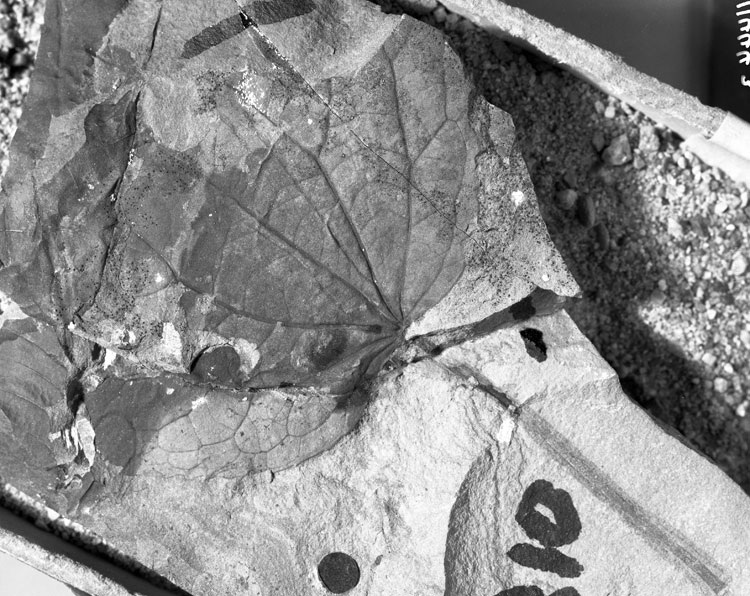Locality
Latitude: 56.268889° N
Longitude: -158.659722° W
Chignik (B-2) Quad.
Collected by R.A. Spicer and J.A. Wolfe.
Floodpain swamp. Lower part of Tolstoi Formation.
Description
Leaf: simple; symmetrical; shape ovate; apex obtuse to acuminate; base shallowly lobate to rounded sometimes with a decurrent junction to the petiole; petiole stout and long; margin crenate except at the base where it is entire, the axes of the teeth pointing towards the apex, sinuses rounded, spacing irregular; venation basal perfect acrodromous, primary midvein moderate more or less straight; pectinals moderate, inwardly curving towards the apex but somewhat angular at the junction of the pectinal abmedials; pectinal abmedials arising at an acute (wide to moderate) angle, curved, brochidodromous, joining the superadjacent abmedial approximately at right angles, the basal abmedials arising so close to the junction of the midvein and pectinals that the base of the leaf has a campylodromous appearance; tertiary veins between the primary, secondary, and pectinal veins are convex, percurrent and occasionally branched once or twice; third order veins looping abmedially from the pectinal abmedials to form festooned loops of at least two ranks with a tendency towards the formation of an intramarginal vein near the base; fourth order veins running percurrently between the secondary and tertiary veins and either straight or forked.
Remarks
A variable feature is the shape of the base at the junction of the petiole which is best demonstrated by comparing specimens USGS 11600.27 and USGS 11600.34. There can be little doubt, however, that these specimens represent the same species. They possess the same crenate to crenulate margin and fundamentally the same venation. There are small differences between specimens but these are all within the range of variation that might be expected within such ancient leaf forms. The similar extant genus Cercidiphyllum Siebold and Zuccarini also exhibits a large degree of variation in leaf form and architecture. Specimen UIDAHO 3/18, 19, 26.2 (Dicot 91) is included in this form because in all respects, except the strength of the tertiaries bridging the pectinals and midvein, it is within the range of variation seen in the specimens from the Tolstoi Formation.
Bell (1949; Plate 46, Fig. 3) illustrates a specimen under the name Trochodendroides arctica (Heer) Bell which is identical to specimen USGS 11600.27 as far as the architecture of the basal portion of the lamina is concerned but, although the apex of Bell's specimen is missing, there is evidence in his illustration of a strong secondary vein leaving the midvein to join the pectinal. The pectinal vein is very weak in the upper quarter of the lamina and it is doubtful if it continues to the apex as it does in the specimens figured here. None of the Tolstoi specimens show any indication of strong brochidodromous curving superior secondaries joining the midvein and pectinals, and in this respect they differ from all the leaves assigned to Trochodendroides Berry by Bell (1949) or Wolfe (1977), as well as extant species of Trochodendron Siebold and Zuccarini and Cercidiphyllum. Perfect acrodromy is, however, seen in Bell's (1949; Plate 52, Fig. 4) Zizyphoides colombi (Heer) Seward and Conway which Bell points out may be confused with small leaves of Trochodendroides arctica. Z. colombi differs from the Tolstoi specimens in being much smaller and apparently entire. The confusion as to the limits of variation in leaf architecture that can be applied to define these genera is reflected in a paper by Berry (1935). In his report on the Middle Ravenscrag flora Berry describes a leaf almost identical to those illustrated here under the name Grewiopsis mclearni Berry (1935; Plate 12, Fig. 3; Plate 14A) which he states resembles forms that had previously been erroneously ascribed to the genus Populus (Tournefort) Linnaeus. His assignment to Grewiopsis Saporta, however, was uncertain as he felt it " *** may be more properly referable to Trochodendroides *** ".
In Hollick's (1936) work on Tertiary plants from Alaska he assigns forms similar to those described here, to 'Populus' zaddachi Heer. Two of his specimens are almost identical to the Tolstoi forms (Hollick, 1936; Plate 24, Fig. 5) but details of the margins are unclear. Brown (1962) considered all his Paleocene leaves of this type belonged to 'Cercidiphyllum' arcticum (Heer) Brown, a species which includes an extremely wide range of form. All his figured specimens can be distinguished from the Tolstoi material in not having the pectinals extending into the apex with the exception of the very small leaves (2.5 cm wide) shown in Brown's figures (1962; Plate 37, Fig. 8; Plate 38, Fig. 2).
Bell reports number of forms of this general type from the Bad Heart Formation of British Columbia (Santonian) and Milk River Formation of Alberta (Early Campanian) under the name Trochodendroides (Cercidiphyllum?) arctica (Bell, 1963; Plate 19, Figs. 1, 3-5 not Fig. 2 and not Plate 18, Fig. 3).
Another extremely similar form well within the limits of variation exhibited here is Trochodendroides sachalinensis (Takhtajan, 1974, p. 117; Plate 47, Figs. 3-8; Plate 48, Fig. 3) from the Coniacian of the U.S.S.R.
The wide variety in form and the different criteria various workers have employed to define species limits have led to a very confusing situation with respect to the systematics of leaves of this general type. A revision is needed which is outside the scope of this work.
